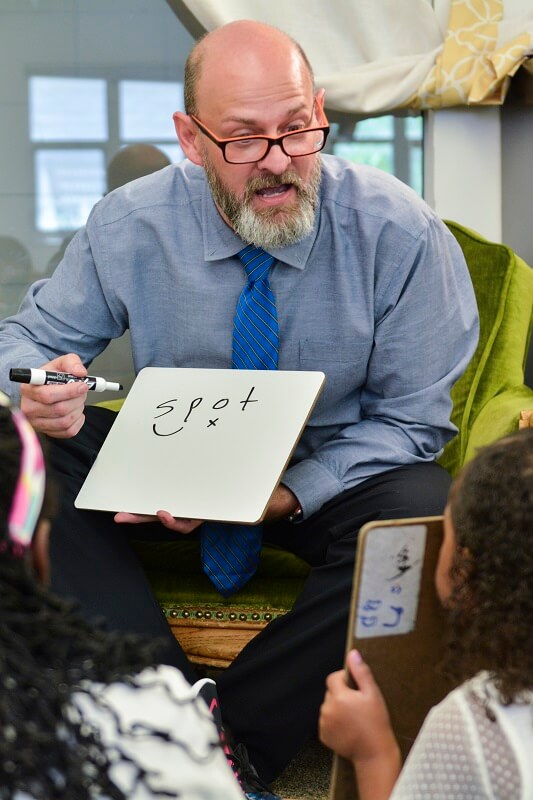 “One of our challenges was how to make us great. We had a hodgepodge of good reading teachers and good things going on, but nothing in common. As Lucy Calkins says, ‘When we can all talk the same language, we can all grow together’. We needed to have a common practice so we could grow.”
“One of our challenges was how to make us great. We had a hodgepodge of good reading teachers and good things going on, but nothing in common. As Lucy Calkins says, ‘When we can all talk the same language, we can all grow together’. We needed to have a common practice so we could grow.”
– Lynn Hobratschk, Assistant Superintendent of Curriculum & Instruction | Friendswood ISD, TX
In any school district, there are great, high-quality K-3 teachers who have mastered the classroom, there are high-performing students, and there are things that are working. But, in school districts all across America, there are also teachers who are less effective. There are students who are falling behind—sometimes without notice. There is limited communication or miscommunication between staff. There are students who need additional support to reach their potential. Could your district reach more students? Could you transform less effective teachers into literacy experts? Could there be improved communication to support the growth of students and teachers?
We wanted to know what really helps districts move the dial on literacy performance, so we went to the source—three school administrators with years of experience in implementing curriculum in their districts. Here they share what they’ve learned and how their approaches to literacy instruction changed the trajectory of many of their students. What worked for them?
1. Build unity with a consistent approach to literacy instruction across your district
A consistent approach to literacy instruction provides several benefits:
- Decreases the cognitive load for students by maintaining a consistent language and instructional method from grade to grade and from RTI tier to tier. This is especially beneficial for intervention students who receive literacy instruction from multiple teachers and have learning differences that make more than one approach confusing and difficult to remember.
- Communication is clearer and more efficient
- Goals are established more collaboratively and progress is more easily measured
- Multiple minds can work to focus on and solve specific challenges and obstacles
- Less adjustment is necessary when teachers and students transfer within the district
2. Involve teachers in major curriculum decisions
Improvement comes faster when everyone is on board. To promote teacher buy-in on major curriculum initiatives and changes, involve teachers in the selection process. Invite teachers to initial sales presentations, send surveys to teachers as you evaluate program options and needs, and/or assign teachers to evaluate specific programs or participate in pilots.
3. Implement a strong word study/phonics-based approach to literacy instruction across grades K-3
When looking to improve literacy improvement district-wide it is crucial to get the right approach in place. Research has found that reading performance improves when students get a strong foundation in phonics-based word study. When this type of instruction is in place in general education (Tier I classrooms), intervention and Special Education demands are often significantly decreased.
4. Build teacher expertise
Pre-service teacher training programs often fail to provide specifics on how to deliver appropriate research-based phonics/word study instruction. When implementing this approach, training for teachers is an essential component. The right type of training increases the effectiveness of every teacher and improves teacher buy-in. When teachers understand the need for explicit and systematic instruction and how it more effectively supports literacy development, they gain the expertise that their students so desperately need.
5. Assign teacher leaders
Another key element in successful long-term sustainable implementation is the development of teacher leaders within the district. This kind of capacity building recognizes that when schools train teachers to become experts in phonics-based word study, they create a valuable resource for other teachers. Teacher leaders can serve as mentors and trainers, provide modeling of instruction with fidelity, and be a voice for literacy during Professional Learning Communities. When teachers own the process, instruction is much more likely to be consistent from classroom to classroom.
6. Train school administrators on literacy programs
It is important to have school administrators trained in each program implemented within the school. When administrators are involved in planning and monitoring, they are able to work more closely with teachers to set expectations for implementation and to accurately evaluate program effectiveness.
7. Use a universal screener to identify student needs and measure growth
Universal screening provides important data for ensuring that the most appropriate interventions are delivered to the students who need them. By screening each K-3 student for the early indicators of reading difficulties, including dyslexia, teachers can more readily identify the specific student needs in their district, clearly define criteria for tier-based instruction, monitor overall improvement, and provide earlier intervention for struggling students.
Try this free online dyslexia screener ›
8. Utilize online tools for ongoing teacher support and professional development
The faster teachers can get answers to their questions and access professional development, the faster improvement will come. Online training tools can provide resources for teachers as they implement the research-based approach to reading instruction, prepare paraprofessionals to assist students, support training for teachers who come in after the initial implementation, and reduce reliance on outside specialists.
9. Nail it then scale it
You don’t have to do everything at once. Choose one school, one grade level, or one classroom to pilot a program. Work out the challenges with a small implementation and then expand the program based on experience and results. You might want to start with a kindergarten and first-grade implementation and then expand the changes to second and third-grade classrooms. Having implementation follow the students who have received previous instruction supports improved literacy outcomes and reduces the need for intervention in the upper grades.
